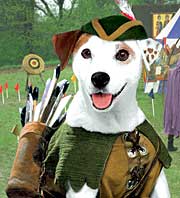

 |
Wishbone reruns, a selling point for the Go! channel, will come back to PBS anyway. |
After fewer than half of PBS stations made commitments to carry a proposed multicast channel for school-aged children, the network pulled back its plan to launch PBS Kids Go! as a fully packaged DTV multicasting service in October. The network is instead exploring its options to distribute school-age fare via video-on-demand or broadband platforms.
“I don’t want to bring up a service and not have the resources to support it,” said PBS President Paula Kerger, who announced the decision to stations July 6 [2006]. Only one-third of public TV licensees expressed interest in paying for Go! as an a la carte service, while PBS needed buy-in from least half, she said.
The network started planning PBS Kids Go! for 6- to 8-year-olds early last year under then-President Pat Mitchell. Because the PBS Kids Sprout cable venture has exclusive rights to key titles for preschool children, the network shifted its attention to the slightly older audience.
With Disney reporting high demand for its experimental broadband service for older kids, Kerger hopes to find similar ways to deliver content to Go!’s target audience of “tweens” — kids who have outgrown preschool fare but are too young for much of the content found on kids’ cable networks. PBS has sought to differentiate its children’s service by providing educational, noncommercial fare to this audience.
Disney executives recently told Multichannel News that their experiment with video broadband delivered 74.1 million streams of full-length kids programs from June 2 to July 6. The site (tv.disney.go.com/disneychannel/video) drew 6.7 million users and 29.5 million page views. It offers full-length episodes of That’s So Raven and Kim Possible, among other titles.
Kerger takes this as evidence that older youngsters can be found on the Internet. “Kids are heavy users of VOD and Disney has played a big role in broadband distribution of content,” Kerger said “If there was not enough content for a [PBS] multicast channel, this should be our focus, because this is where the kids are.”
PBS may offer the Go! channel again later on, depending on stations’ needs, Kerger said. “Some stations have already developed their own local services and others don’t have digital carriage agreements with their cable operators. We were probably a year early in offering it as a digital channel.”
The Go! packaged channel offered exclusive rights to two retired but once-popular PBS titles, Wishbone and Kratts’ Creatures, plus a new live-action show Kids World Sports, in addition to several series already available to stations. But many stations found the price was too high.
Licensing fees for Go! ranged from $54,000 to $3,375, depending on the size of the stations’ markets. The pricing tiers were 10 percent lower than for the PBS-HD Channel, which many stations stretched their budgets to buy last fall.
The exclusive program rights that came with Go! license weren’t as substantial as those conveyed for PBS-HD, said Scott Dwyer, p.d. at KQED in San Francisco.
“It was a difficult stretch for PBS to make it work,” he said. “We felt it was a bit steep for what we were getting.”
Nevertheless, KQED planned to license Go!, even though the station is already programming its own kids’ multicast service. “It would have been a good addition and given us a couple more shows to help with differentiation,” Dwyer said.
PubTV’s digital carriage agreement with major cable operators requires stations sharing a geographic market to differentiate their services, and KQED’s merger with KTEH in San Jose has made differentiation an even higher priority.
“I don’t think that it signals a failure of commitment by PBS or on the system’s part,” said Brigid Sullivan, v.p. of children’s education and interactive programming at Boston’s WGBH, one of the top producers of programs for school-age kids. “There’s a financial scramble going on right now, but once it gets sorted out I’m assuming there’s going to be a continuing commitment to older kids.”
In the meantime, as CPB prepares to review criteria for stations’ community service grants, PBS will look at its pricing formula and a la carte method of offering new services.
“The HD channel was successful, but for this one not enough stations signaled the need for it,” Kerger said. “I’m trying to be very focused on what stations really want.” She expects more stations will gain interest as they complete their digital conversions and make multicast deals with local cable systems.
The channel for ages 6 to 8 was proposed to replace the PBS Kids channel for tots and school-age kids, which ended last fall. DirectTV’s licensing agreement, which had subsidized the channel, expired last fall, and digital cable rights for the preschool-age programs shifted to the PBS Kids Sprout channel co-owned by Comcast, PBS and two major producers, Sesame Workshop and HIT Entertainment.
PBS is working out arrangements to distribute some of the titles planned for digital Go! channel on its analog children’s service. Beginning in January, Wishbone will reappear weekly on the National Program Service, according to John Wilson, senior programming v.p. Animalia, a CGI-animated fantasy that was to appear exclusively on Go! next year, will be offered through PBS Plus, a service distributing fully underwritten programs to PBS stations.
Web page posted Sept. 2, 2007
Copyright 2006 by Current Publishing Committee